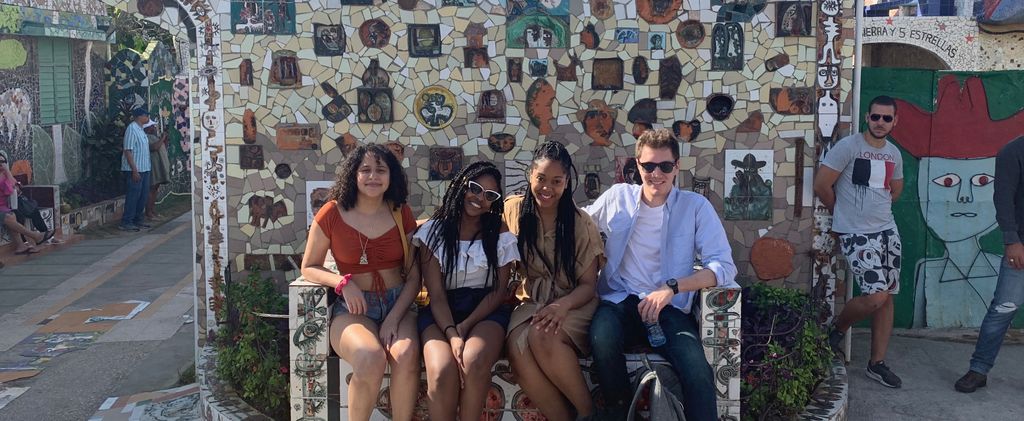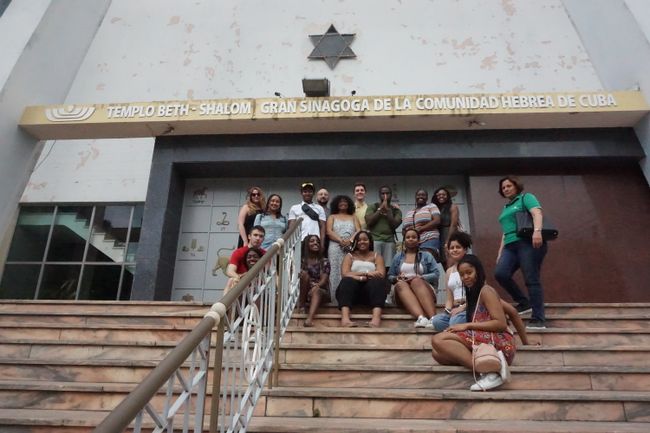Experiencing Cuba: An Expeditionary Course on Cuban History and Art

April 2019 | by Priscilla Valdez (COM’19)
This spring break Michael Birenbaum Quintero, Professor of Musicology & Ethnomusicology, and Cynthia Becker, Professor of African Art, led a group of undergraduate students to Havana, Cuba on an immersive expeditionary course – “Experiencing Cuba: History, Culture, and Politics.” The course material intersected themes of African and Cuban music, art and religion as seen throughout history and today.
Fourth year graphic design student Joseph Schianodicola (CFA’19) said that after focusing so heavily on Western European art in his classes, he felt it was crucial to familiarize himself with art from other parts of the world. “Having embarked on this Cuban experience, I feel as though I’ve had the chance to engage with a design culture and history unique to Cuba.”
“The language and voice of Cuban design is visceral and very energized, attributes that stemmed from the spirited posters of the Revolution,” Schianodicola said. “Furthermore, the analog means of production – lithography, woodblock printmaking, etching, and such – are still very much alive, and thriving in Cuba, something that seems to be more of a niche craft in the United States.”
The unique course is held every spring and aims to connect Afrocuban religious and cultural practices with the art seen in Cuba today. Students were able to analyze these themes firsthand throughout their busy itinerary which included visits to various museums and performance centers, a graffiti tour, in-depth lectures by Quintero, Becker and several Cuban professionals, and even a dance lesson.
Having led the course for several years, Quintero is able to bring his experience on the island, along with his interest in the evolution of how “blackness” has been expressed in music from colonialism through to today. He presented a lecture to the students on this very subject, discussing Cuba’s historical relationship with slavery, and how the country’s expressive culture reflects this still today.
Likewise, Professor Becker’s expertise on African studies brought historical insight to the course, providing students with the background information necessary to see their experience in Cuba through a different lens. Becker’s lecture to the students explored modern art of the 1940s to 1980s, discussing how it reflected Afrocuban religion of the time, and how Cuba responded to it.
[bu_slideshow show_id=”65728″ show_nav=”1″ transition=”slide” nav_style=”icon” autoplay=”1″ transition_delay=”5″ width=”auto” shuffle=”0″]
Students also met with several professionals in the fields of art, history, and education, among them Afrocuban film maker Gloria Rolando and University of Havana professor Maria de los Angeles Pereira. Rolando examined more unpleasant elements of black history that aren’t often highlighted, like the massacre of people of color in Cuba in 1912. While Pereira reviewed contemporary art in Cuba over the last 20 years, highlighting themes of race, gender, sexuality, and exile.
Though the course heavily focused on the arts in Cuba, students came from all different schools and majors in Boston University, many with minors in African American Studies. Professor Quintero explained how actually visiting Cuba is crucial to the course, and delivers a much more powerful message about race and culture than could have been taught in the classroom.
“One of the things that’s really important about Cuba is that people can see there are very different ways that race relations can work,” Quintero explained.
Along with examining Cuba’s past, the course could not deny the importance and relevance of Cuba’s political state and relations today. The group visited the Instituto Cubano de Amistad con los Pueblos (the Cuban Institute for Friendship with the Towns) to learn about how Americans can show solidarity with Cubans.

“I think the most significant takeaway from this experience was gaining insight to a different side of the story,” reflects Joseph Schianodicola. “I’ve undoubtedly recognized my privilege as an American. However, I’ve also realized just how misconstrued my preconceived notions, and the preconceived notions of others, of Cuba truly are.”
Being able to visit the studios of living artists, go on a graffiti tour led by local graffiti and hip-hop artists, and taking a lesson on traditional Cuban dances of Salsa, Rumba and Yoruban dance is something many would call a once-in-a-lifetime opportunity.
“People really related with the Cuban people, and you could see what Cuban people themselves think about living there and the way in which they actually live their lives,” said Professor Quintero.
Overall, students thoroughly enjoyed the course for its blend of educational, artistic and cultural experiences that helped them understand Cuba on a much deeper level.
“As some other students and I discussed while in Cuba, we did not learn much about Cuban history in high school history class, but whatever we did was very negative and disparaging,” said Schianodicola. “In truth, Cuba is a beautiful nation, with welcoming, inquisitive people, still in recovery from the destructive effects of colonialism and neo-colonialism far back in its history – something I would have only learned having gone through this experience.”